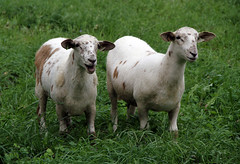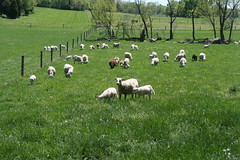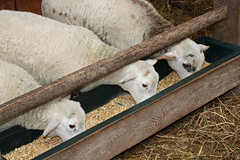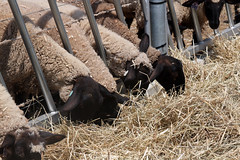|
Let's ruminate on it Sheep belong to the ruminant classification of animals. Ruminants
are characterized by their four-chambered stomach and "cud-chewing"
behavior. Cud is a food bolus that is regurgitated, rechewed, and reswallowed. Intermediats, such as sheep, goats, and white tail
deer, have nutritional requirements midway between grazers and
browsers. Of this group, sheep are more of a grazer, while goats
and deer are more browsers.
Young ruminants At birth, the lamb's rumen and reticulum are not yet functional. As lambs begin to nibble on dry feeds, these two compartments become innoculated with microorganisms. As the microbes multiply and begin to digest feed, they stimulate the growth and development of the rumen and reticulum. The lamb's rumen and reticulum are usually functional by the time the lamb is 50 to 60 days old. Because lambs are not born with a functioning rumen, supplemental feeds, such as creep feed, need to be highly digestible. Creep rations typicaly consist of feedstuffs that have been cracked, rolled, ground, or pelleted. Cracked corn and soybean meal are common ingredients in creep feed. Creep feeding enhances development of the rumen in the young lamb. In fact, the rumen in creep-fed lambs will develop quicker than the rumen in lambs that are fed strictly a forage diet. Grazers by design Though ruminants can digest grain (starch), their more natural diet is forages: grass, weeds, browse, hay, and silage. If too much grain is consumed at one time or the diet is switched too quickly to grain, a large amount of lactic acid is produced in the rumen and the pH of the rumen drops. This can be a fatal condition to the ruminant animal. Grain must be introduced slowly to the diet of ruminants to give the rumen time to adjust, which it can easily do. Not too much grain Sheep "love" the taste of grain. It's like "candy" to them. They will overeat if grain consumption is not regulated. If grain is slowly introduced to the ruminant's diet, grain can be supplemented and in some cases replace some (even most) of the forage in the diet. Whole grain is better for sheep because it requires them to do their own grinding of the grain. Digestive upsets are less common with whole grain as compared to processed grains (ground, rolled, or cracked). Coarse grain are preferred to finely ground grains. Some forage should always be fed to ruminants to keep their rumens functioning properly and to keep them content. Sometimes, if a sheep doesn't get enough forage in its diet, it will pick at another's wool. Read article The truth about feeding grain to sheep and goats=> Greenhouse gases An environmental impact of ruminant livestock production is that when ruminants belch (burp), they emit methane, a powerful greenhouse gas. A small amount of methane is also produced from their manure. While estimates for domestic ruminants' contribution to methane emissions are typically overblown (and politicized), ruminants are a source of methane. It is estimated that cattle and other ruminant livestock contribute 37 percent of the methane that is attributed to human activity, with cows contributing most of that. Less methane is produced in intensive livestock systems as compared to more extensive, pastoral systems. This is because grain diets result in less methane being emitted. Scientists
are studying other ways to reduce methane production from ruminant
livestock. For example, livestock fed certain
plants produce less methane. Genetics also affects the amount of methane that a sheep emits. Australian researchers have determined the low emitting trait to be about 20 percent heritable, with some added benefits; the sheep are more efficient. Australian scientists are also testing
a vaccine to reduce methane emissions. |
|||||||||||
|
|









